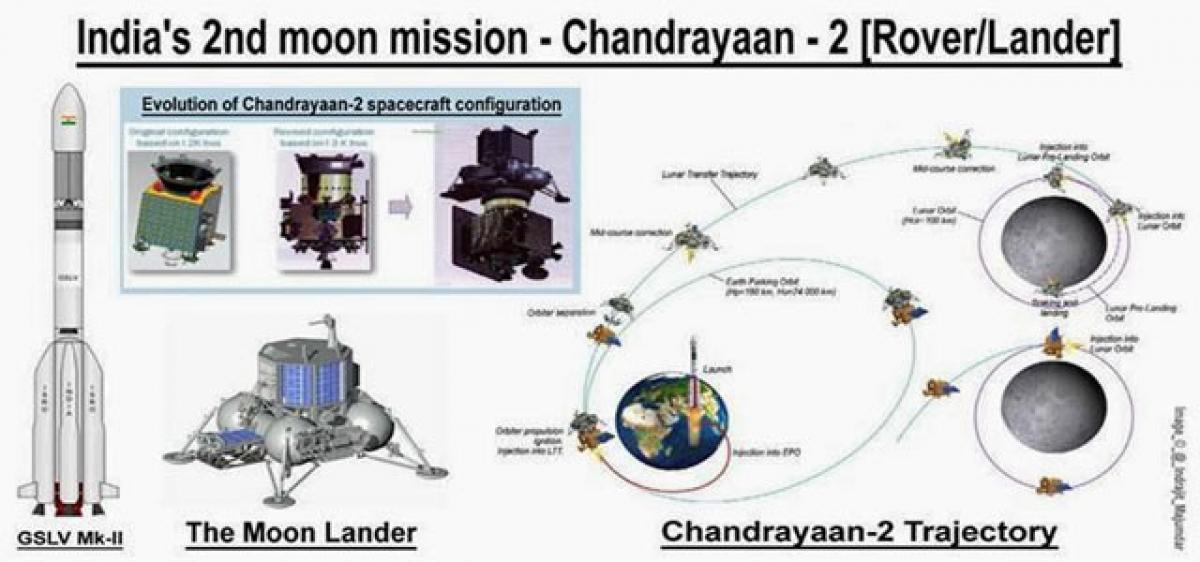Live
- YSRCP forms spl teams to support social media activists
- AI-driven dataset to reveal new insights around diabetes
- Nurturing curiosity, empathy & innovation in children
- Vizianagaram MLC bypoll cancelled
- Governor Abdul Nazeer pays tributes to Pandit Nehru
- AP Assembly session continues for fourth day, discussion on budget today
- YSRCP leader Gowtham Reddy booked for attempt to murder
- Chief Minister A. Revanth Reddy Extends Kartika Purnima Greetings
- CM A. Revanth Reddy Wishes People on Guru Nanak Jayanti
- Wanaparthy District: On Friday morning, a tourist bus lost control and went into the crop fields on National Highway
Just In

Isro lost communication with Chandrayaan-1 on August 29, 2009, barely a year after it was launched on October 22, 2008. Chandrayaan-1 is still circling some 200 kilometers above the lunar surface. It was launched on October 22, 2008 from SDSC SHAR, Sriharikota.
After the successful launch of Geosynchronous Satellite Launch Vehicle-Mark 3 D1 (GSLV-Mark III), its heaviest rocket till date, Indian Space Research Organisation (Isro) will be gearing up for Chandrayaan-2 in the first quarter of 2018. India's first lunar mission, the Chandrayaan-1 spacecraft, which was generally considered lost, is still orbiting the Moon.
Isro lost communication with Chandrayaan-1 on August 29, 2009, barely a year after it was launched on October 22, 2008. Chandrayaan-1 is still circling some 200 kilometers above the lunar surface. It was launched on October 22, 2008 from SDSC SHAR, Sriharikota.
The satellite made more than 3400 orbits around the moon and the mission was concluded when the communication with the spacecraft was lost on August 29, 2009. Chandrayaan-2 is planned to be launched to the Moon by a Geosynchronous Satellite Launch Vehicle (GSLV Mk II).
It includes a lunar orbiter, lander and rover, all developed by India. It will test various new technologies and conduct new experiments. The wheeled rover will move on the lunar surface and will pick up soil or rock samples for on-site chemical analysis. The data will be relayed to Earth through the Chandrayaan-2 orbiter.
Unlike Chandrayaan-1's Moon Impact Probe, which impacted the Moon's surface, the lander will make a soft landing to deploy the rover. The approximate mass of the lander and rover is 1,250 kg (2,760 lb). Russian company Isotope has supplied Cm-244 alpha-emitter to be installed in a scientific instrument in India's Chandrayaan-2 satellite.
It enables sources to determine chemical composition of any rocks and soils. It will be installed on the Alpha Proton X-Ray Spectrometer (APXS) aimed at analysing the lunar surface within the India's second lunar exploration mission Chandrayaan-2. Another interplanetary mission of Isro will be Aditya L1.
The Aditya-1 mission was conceived as a 400kg class satellite carrying one payload, the Visible Emission Line Coronagraph and was planned to launch in a 800 km low earth orbit.
A satellite placed in the halo orbit around the Lagrangian point 1 (L1) of the Sun-Earth system has the major advantage of continuously viewing the Sun without any occultation/ eclipses.
Therefore, the Aditya-1 mission has now been revised to “Aditya L1 mission” and will be inserted in a halo orbit around the L1, which is 1.5 million km from the Earth.

© 2024 Hyderabad Media House Limited/The Hans India. All rights reserved. Powered by hocalwire.com







